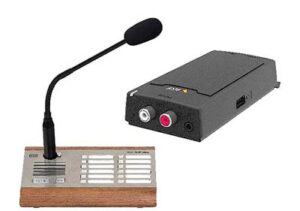Benchmark has looked at the potential for implementing network-based audio as an element of value-added smart solutions, and has also considered the business case for such an approach. In this article on network-connected audio, created with the help of Axis Communications, the benefits for customers are assessed, allowing integrators and installers to see how the technology can win contracts.
Network-connected audio technology is one element from the wider Internet of Things (IoT) that offers a good fit with smart security solutions. In a number of applications, the use of IP-connected audio can add value and deliver real benefits for end users. Audio delivers an additional layer to security systems, as it allows challenges to be made and instructions to be given remotely by a system operator. However, outside of security usage, the associated audio devices and systems can be used for a wide range of other tasks.
Audio challenge has been accepted as a powerful element in modern security solutions for many years now, and was an instrumental element in allowing qualifying video surveillance systems to attract police first response. The ability of a system operator to verbally challenge intruders, using specific terms of reference such as mentioning the colour of their clothing or giving details of what they have been seen doing, often results in the targets leaving the area with some urgency. Also, if a safety-related incident occurs, the system can be used to issue guidance to those in the area, such as managing an evacuation by giving real-time instructions.
Alongside security, audio-based systems also present new opportunities for system integrators and security installers. Dependent upon the application, network-connected audio can deliver a flexible and future-proofed solution providing a wide range of IoT benefits.
These can include public address announcements, welcome messages, help and call points, intercom functionality, background music, etc.. By considering the wider implementations of network-based audio, smart solutions enable customers to integrate the security solution with other business functions, thus creating the added value end users are seeking.
Varied applications
New developments for smart solutions are always on the horizon, and forward-thinking system integrators and security installers can lead the way with regard to the development of cutting-edge bespoke solutions. IoT additions, and specifically network-based audio, are no longer visions of the future. They are available today, and end users are already realising everyday benefits.
 To simplify the available options from audio technology, it is worth breaking implementations down into three distinct classifications. These are security, public address and background audio.
To simplify the available options from audio technology, it is worth breaking implementations down into three distinct classifications. These are security, public address and background audio.
Today’s rapidly evolving technological landscape means that new and emerging options are cropping up on a regular basis, and this is having an impact on end user expectations. As a result it is essential for those designing security applications to also look at trends within other market sectors.
The use of audio for security solutions is one area where change is ongoing. Network-based audio is an ideal addition to a video-based solutions. A good example is the use of audio-based notifications in perimeter protection implementations. Persons loitering near a boundary or seen tampering with fences can be warned off, and any direct trespass can result in a warning that the police have been notified.
Where an intrusion is innocuous, such as children retrieving a ball or someone trying to catch a runaway dog, appropriate advice can be issued.
Security-specific audio communications might also cross into the realm of public address (PA) audio. In a wide range of environments, including sites as diverse as schools, retail stores, hotels, factories and public buildings, there can be a need for informative messages and status updates to be communicated to those in the area.
These messages may be as simple as calling a member of staff to a specific area, informing visitors that a facility is due to close for the day or informing separated families that a lost child has been found.
Adding public address communications is a simple process when network-based audio technology is deployed. Furthermore, messages can either be triggered by other system devices or issued manually by the operator.
With regard to automated announcements, these can use smart technologies such as VMS rules or action rules from open platform devices, allowing analytics or site status notifications to trigger messages. For example, a camera-based edge application such as AXIS Queue Manager could detect POS queues in a retail environment and play an announcement requesting all till-trained staff to go to the checkouts when pre-determined thresholds are exceeded.
Because of the flexibility of action rules, PA announcements can be triggered by a wide range of events, including (but not limited to) inputs and outputs, IVA, motion detection, device tampering, system status changes, access control transactions, infrastructure exceptions, etc.. Announcements can also be scheduled.
Finally, background audio technologies may sound somewhat peripheral, but these services are increasingly being deployed in a growing number of applications.
Background audio is popular with retail stores and hotels for the delivery of background music. With pre-set volume and music choices, the solution allows for central and remote control, meaning enhanced management of background music. The music can be combined with scheduled and live announcements, further helping to enhance the customer experience.
With research indicating that productivity, mood and behaviour are positively influenced by music, it is something that can be actively exploited in retail and manufacturing environments and as such a solution that allows the management of background music along with PA and security announcements does add value for the customer.
Network advantages
Networked audio solutions such as those available from Axis Communications offer a complete all-in-one system that integrates seamlessly with network-based video surveillance. No additional hardware is required above the actual audio components, which simplifies the installation and configuration processes. In addition, the systems have minimal storage requirements.
 Fewer components mean lower costs, so the return on investment for end users is significantly increased. With a network-based solution the controls are software-based, which is a great benefit when it comes to system maintenance.
Fewer components mean lower costs, so the return on investment for end users is significantly increased. With a network-based solution the controls are software-based, which is a great benefit when it comes to system maintenance.
System management and fault search are both easier to control with an IP-based audio solution. Each speaker can be directly integrated within the existing data network, and can then be managed remotely via a PC or workstation.
Products can be added and removed easily and effectively. It is always preferable to seek audio components that support PoE (Power over Ethernet). This means only one cable is required per product to supply power to the unit and transmit sound and data, reducing installation time and costs.
Audio solutions may make use of innovative technologies, but they should also be simple and accessible.
This simplicity is a great advantage to the end users and integrators alike. Indeed, for the latter, audio installations are very straightforward.
If an engineer possesses the required skills to install a network camera, they will also have the skills to install an audio system alongside it. It is easy to add and remove speakers as configuration takes place centrally.
For example, in an office environment the customer does not have to set sound zones and volume levels in advance. This process can be managed after the implementation. The result is that the customer is not tied to a system which might become expensive and difficult to renew and refine. When delivering audio connectivity, it is important to understand flexibility is critical.
A network-based audio system can also be integrated with other network products. For example, an access control system where a door control unit is linked with a network camera and a speaker creates a complete security solution for entrance monitoring.
In conclusion
In today’s high-technology society, intelligence is at the centre of effective solutions. By adding network-based audio systems with intelligent functions, value is added to the overall system. Smart audio-based applications can be loaded into Axis audio devices via the ACAP platform, adding functionality such as sound analysis. Smart networked audio adds value, and therefore differentiates forward-thinking integrators.








